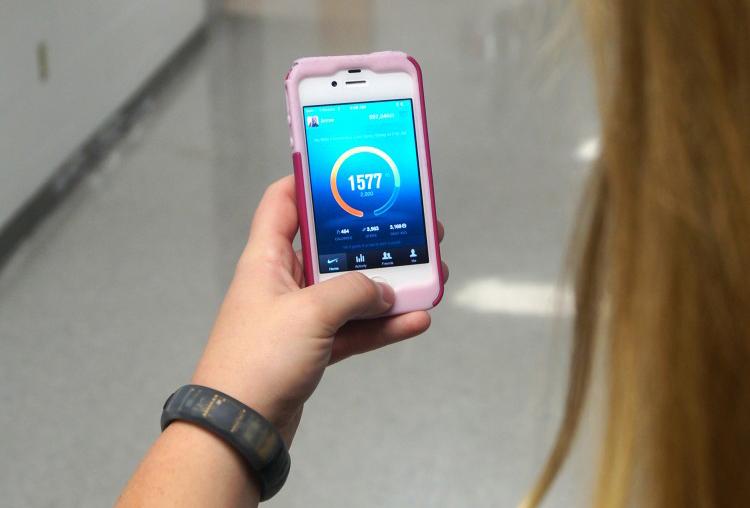Technology takes exercise and health tracking to a new level
Junior Annie Applehoff uses bands to track her own exercise and health data.
Between the busy schedules of school, sports, clubs, homework, family time, and rest, concentrating on fitness can be hard to fit in everyday. Researching the amount of calories eaten in a day and trying to recall the exact amount of sleep one got can be difficult and a waste of time. Now, just a small bracelet and the push of a button can track the way users are living life. Jawbone’s UP bracelet and Nike’s Fuelband+ contain features to help users chart and discover all health habits to help push athletes and others into becoming fit.
Assisting in smarter sleeping, eating, and exercise, the Jawbone bracelet UP tracks everything in user’s lives. The bracelet came out in 2011 and is now being currently used worldwide. The app paired with the UP bracelet, called UP, can be synced through a smartphone to individual users’ bracelets. It gives feedback about patterns found based on users’ activity.
The app has the ability to log moods and make connections with how customers feel based on activity. Not only can it track how many hours of sleep a night users get but, also has the ability to wake users up at the optimal time of their sleep. The bracelet vibrates at the perfect time of a natural sleep cycle to wake users up, feeling refreshed and ready for the day. The bracelet also contains a feature to track light vs deep sleep. UP can wake up users at the ideal time during a nap in order to get the maximum amount of energy and rest possible during a so called, “power nap”. Senior Jacqueline Bieter uses the Jawbone UP to track her health and sleep patterns. “I have a hard time waking up in the morning and the Jawbone helps make mornings easier and more natural to wake up.” Bieter said.
Jawbone’s UP not only track the amount of calories burnt, but it can also track the amount of high intense cardio vs low impact cardio on the body. Tracing calories burned, it also tracks calories gained from the food you eat. The Jawbone contains motion sensors that allows movement to be tracked by detecting changes in acceleration. “The Jawbone helps me stay on top of my health stats so I can focus on my athletic training,” Bieter said.
Another company, Nike, created a bracelet similar to Jawbone’s UP bracelet. The Nike+ Fuelband bracelet solely tracks movement and the amount of activity. The bracelet can be paired up with smartphones to receive feedback and set goals. The app allows bracelet users to connect with friends who also are using the bracelet, making it easier to get active with others. It gives motivational feedback in order to encourage users to meet their goals. The bracelet lights up while being used and can show the time and amount of calories burned so far during the current day. The band also tells users how close they are to meeting their daily goals.
The Nike+ Fuelband also contains a GPS to track the places of users exercise along with a device that counts steps. Fuelband user, junior Annie Applehoff finds the band to be very helpful and motivational. Applehoff has no complaints except for that the band is not waterproof and can be considered an annoyance to take on and off to avoid water. “I have enjoyed my Nike Fuelband because it has helped motivate me to be active everyday. It is also a fun tool to track my workouts,” Applehoff said.
When comparing the Nike+ Fuelband and the Jawbone UP side by side, UP sells for $10 less than the Nike+ Fuelband, but provides more features. Although UP includes a larger variety of uses for everyday life, the Fuelband is better for goal setting and getting active with other friends. If users are looking for a product to track everything that affects their everyday lifestyle than the Jawbone UP would be the ticket. But, if users are searching for a way to connect with friends and become more fit through mainly exercise, the Nike+ Fuelband is right for them.
Although the bracelets are costly, if used daily, they are well worth the money. But if not used daily, the bracelets may be pointless to purchase. They also may not be worth the money if a potential buyer already keeps very good track of their health. These bracelets may not be useful to all buyers but can potentially be life changing if used correctly.






































![Teacher Lore: Mr. Hillman [Podcast]](https://bsmknighterrant.org/wp-content/uploads/2025/03/teacherlorelogo-1200x685.png)




